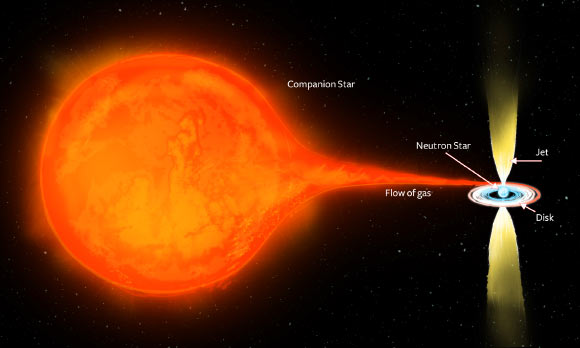Neutron stars may rival black holes in their ability to accelerate powerful jets of material to nearly the speed of light, says a group of scientists from the Netherlands and Australia.

An artist’s impression of the binary system PSR J1023+0038: the extremely dense, rapidly-spinning neutron star, just 10-15 km in size, is in a close orbit with a more normal companion star. The strong gravity of the neutron star pulls gas from its companion, which spirals in towards the neutron star, forming a disk. Some fraction of that gas gets accelerated outwards in energetic, oppositely-directed jets, which give off the radio waves that can be seen by Earth’s radio telescopes. Image credit: ICRAR.
Black holes and neutron stars are respectively the densest and second most dense forms of matter known in the Universe.
In binary systems where these extreme objects orbit with a normal companion star, gas can flow from the companion to the compact object, producing spectacular displays when some of the material is blasted out in powerful jets at close to the speed of light.
Previously, black holes were the undisputed kings of forming powerful jets. Even when only nibbling on a small amount of material, the radio emission that traces the jet outflow from the black hole was relatively bright.
In comparison, neutron stars seemed to make relatively puny jets. A neutron star sedately consuming material was therefore predicted to form only very weak jets, which would be too faint to observe.
Recently, however, combined observations of the binary system PSR J1023+0038 completely contradicted this picture.
The system, which was discovered in 2009, contains a neutron star in a close orbit with another, more normal star nearby.
When observed in 2013 and 2014, it was accreting only a trickle of material, and should have been producing only a feeble jet.
“Unexpectedly, our radio observations with the Very Large Array showed relatively strong emission, indicating a jet that is nearly as strong as we would expect from a black hole system,” said team member Dr Adam Deller of the Netherlands Institute for Radio Astronomy (ASTRON).
“PSR J1023+0038 is a ‘transitional’ neutron star, spending years at a time powered mainly by the rotation of the neutron star but transitioning occasionally into an active gathering state, when it gets much brighter.”
“Two other transitional systems are now known and both of these have also been shown to exhibit powerful jets. This is casting neutron stars in a new light and showing that in fact they can sometimes launch jets to rival those coming from black holes,” said Dr Deller, lead author on the study published in the Astrophysical Journal (arXiv.org preprint).
_____
A.T. Deller et al. 2015. Radio Imaging Observations of PSR J1023+0038 in an LMXB State. ApJ 809, 13; doi: 10.1088/0004-637X/809/1/13







